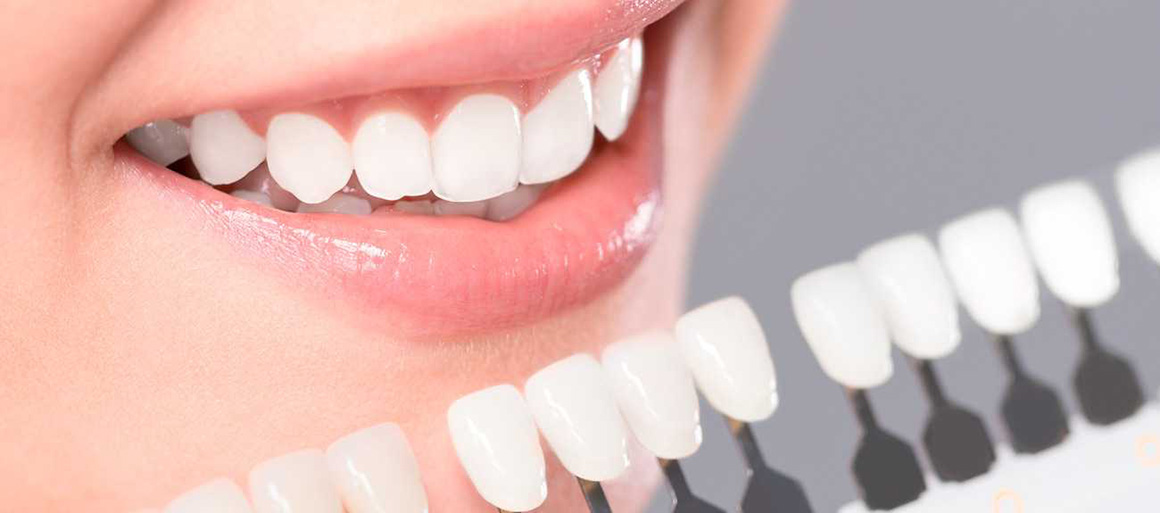The aesthetics of the smile is determined by several factors, which must be considered together in order to carry out a satisfactory rehabilitation. These factors are: facial aesthetics, dental position, presence of dental absences, tooth color and dental tooth form. Thus, it is important to assess the need of orthodontic treatment and the need to rehabilitate dental absences with prosthetic dentistry (see its corresponding sections). In this section we will talk about dental whitening and rehabilitation with veneers and ceramic crowns, whose role is to change the color and tooth shape.
Tooth whitening
What factors affect tooth color?
Some people naturally have darker teeth than others. Some may be more yellow, others more gray or brown. In addition, the teeth become yellow or darken with age. Along with this, the natural color of the teeth can be affected by many factors.
- Superficial stains (extrinsic stains) can be due to:
- Smoking or chewing tobacco
- Drinking coffee, tea or red wine
- Eating very strong colored foods, such as cherries, blackberries red beet and curcuma
- Calculus deposits, which form when bacterial plaque has hardened
Internal stains (intrinsic stains) may be due to:
- Treatment with the tetracycline during the time your tooth formation
- Trauma to the teeth that can cause nerve death
- Excessive fluoride intake during tooth formation
- Color change to yellow or gray as part of the aging process
How to improve the color of your teeth?
- A proper profilaxis will remove most of the stains caused by food and tobacco. However, if the internal color of the tooth is dark, a dental whitening or tooth veneers or crowns, might be needed to achieve a better result.
The decision on the type of treatment to be performed can be complex. We will advise you considering the results you want to achieve, and we will take into account factors, such as:
- The degree and type of stains
- The amount of dental structure preserved and the presence of fillings
-
How does tooth whitening works?
How to perform tooth whitening?
- External bleaching at home

It is the most widely used method today. The dentist will take an impression of your teeth and make you a custom dental vacuum. Shall place small drops of the whitening gel inside the splint and put it on for 2-3 hours, preferably after dinner. The duration is usually about two weeks, although it will depend on the initial situation, and could be extended for several months if necessary. The vacuum will serve to make reminders when the patient deems it necessary.
- External clenching in the clinic
- Internal tooth bleaching
Internal whitening allows the whitening agent to be placed inside the tooth. This procedure is usually fast and effective, although it is usually reserved for isolated teeth that are darker than the rest and have pulp necrosis or an endodontic treatment already performed.
Veneers and crown
Veneers
The porcelain dental veneer is a thin porcelain or composite sheet, the same size as a nail and that is placed by means of an adhesive or special cement on the external face of a tooth.
The dental veneer allows in a less invasive way to correct the shape, position and color of the teeth; Thus recovering the aesthetics of the smile.
Once the veneer is in place, it feels and works like a white, beautiful and normal tooth.
Crowns
The dental crown, especially the 100% ceramic crowns, are also used in dentistry to satisfy the aesthetic requirements of patients. Unlike dental veneers, crowns need more preparation and carving of the tooth, however, it is necessary to opt for this treatment when we want to recover the aesthetics of a tooth whose tooth structure is badly destroyed or when the desired color change is very remarkable.
Both crowns and veneers allow similar results, both aesthetically and functionally. The choice of one treatment or another will depend on the presence or absence of dental structure, the dental position and the color change that we want to achieve.






